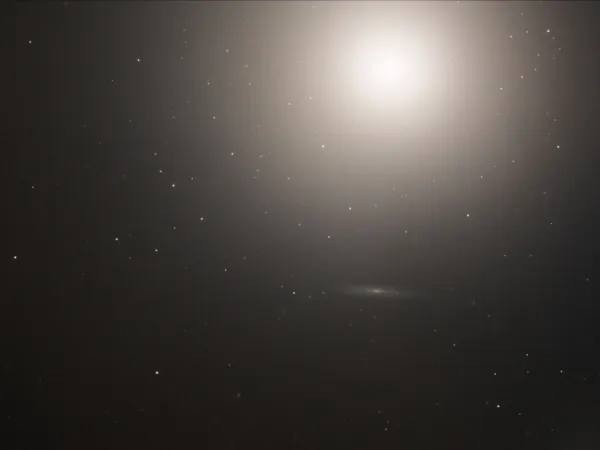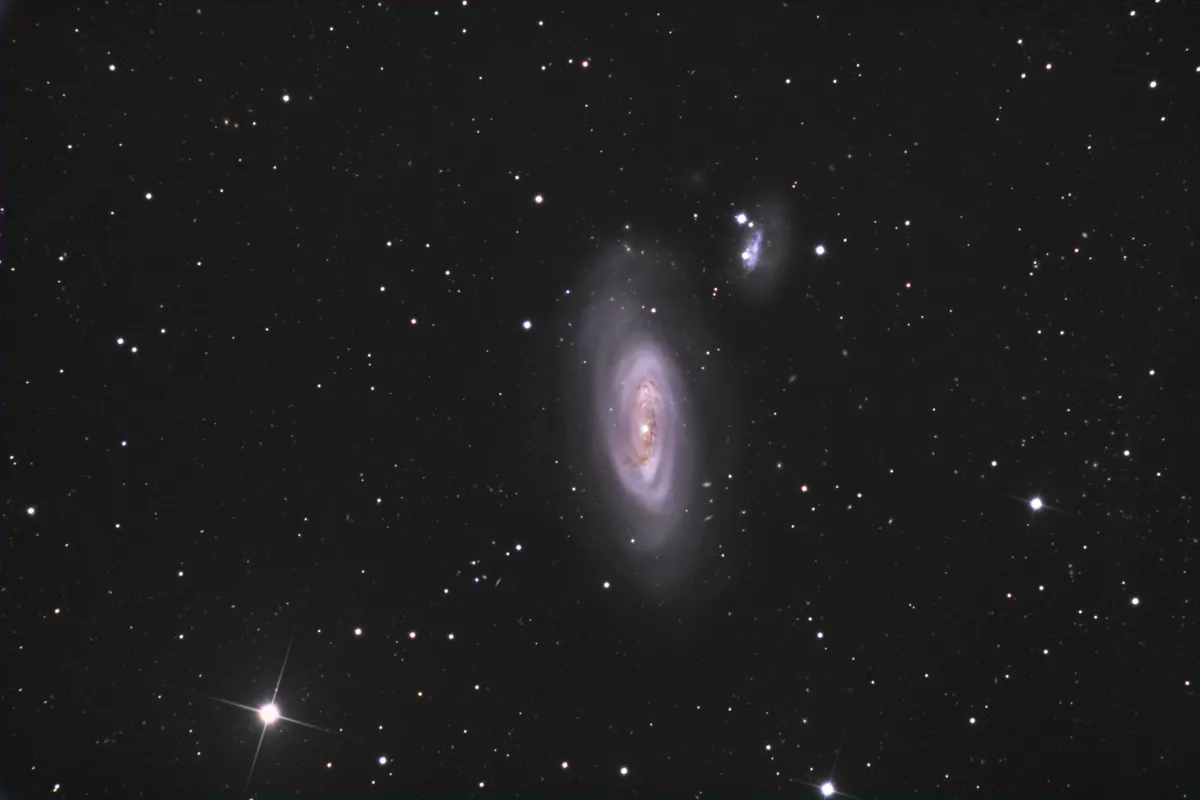Galaxies Messier 89 & Messier 90
History
The galaxy M 89 was discovered by Charles Messier on 18 March 1781. He wrote about M 89: «Nebula without a star, in the Virgo, somewhat distant and reported as No. 87 on the same parallel as the nebula. The light is very weak and rare, it can only be perceived with difficulty.» That same night, Messier also discovered M 90 and wrote the same thing about it as he wrote about M 89: «Nebula without a star, in Virgo: its light is about as weak as the previous No. 89.» [281]
IC 3583 was discovered on 29 April 1892 by the British astronomer Isaac Roberts. [196]
M 90 is listed as Arp 76 together with the small irregular companion galaxy IC 3583 in Halton Arp's 1966 «Atlas of Peculiar Galaxies» as an example of a galaxy with a small companion of high surface brightness. [199]

Physical Properties of Galaxy M 89
M 89 has about 100 billion stars and is an elliptical galaxy in the Virgo Cluster about 55 million light years away from us. Elliptical galaxies are usually in the shape of an elongated ellipsoid, but M 89 appears completely round to us. Presumably its long axis points in our direction. M 89 is slightly smaller than the Milky Way, but has some interesting features. A structure of gas and dust extends up to 150'000 light years from the centre of the galaxy, which is home to a supermassive black hole. Jets with heated particles reach up to 100'000 light years out of the galaxy, suggesting that M 89 may once have been far more active than it is today. Maybe it was an active quasar or a radio galaxy. It is also surrounded by an extensive system of shells and plumes that may have been caused by previous mergers with smaller galaxies. M 89 as we know it today could possibly only have emerged in the relatively recent past. [215]

Physical Properties of Galaxy M 90
M 90 is a beautiful spiral galaxy and about 59 million years away from us. It contains about one trillion (1012) stars and 1000 globular clusters. With the exception of the inner region, few new stars form in the arms. Past interactions with neighboring galaxies have probably taken gas and material that M 90 would need for the formation of new stars in the outer regions. In the future, M 90 could evolve into a lenticular galaxy. In contrast to most other galaxies, M 90 does not move away from us, but comes towards us. It seems to revolve around the colossal centre of mass of the Virgo cluster. This is moving away from us, but the M 90 is moving faster. [215] Measured distances are ranging from 9 Mpc to 18 Mpc. [145]

Physical Properties of Galaxy IC 3583
IC 3583 is an irregular dwarf galaxy. According to measurements, it is at a distance of 8.2 to 17 Mpc (26 to 55 million light years) and lies in about the same distance as M 90. [145]
| Name | RA | Dec | Type | bMag | vMag | B-V | SB | Dim | PA | z | D(z) | MD | Dreyer Description | Identification, Remarks |
|---|---|---|---|---|---|---|---|---|---|---|---|---|---|---|
| NGC 4531 | 12 34 15.8 | +13 04 33 | Gx (SB0-a) | 12.3 | 11.4 | 0.9 | 13.3 | 3.1 × 2 | 155 | 0.000650 | 2.75 | 15.200 | F, pL, R, vgbM | WH II 175; h 1333; GC 3081; UGC 7729; MCG 2-32-141; CGCG 70-175; VCC 1552; IRAS 12317+1321 |
| NGC 4552 | 12 35 39.9 | +12 33 22 | Gx (E0) | 10.7 | 9.8 | 0.9 | 13.2 | 3.5 × 3.5 | 0.001134 | 4.79 | 15.550 | pB, pS, R, gmbM | h 1348; GC 3097; M 89; UGC 7760; MCG 2-32-149; CGCG 70-184; VCC 1632 | |
| NGC 4569 | 12 36 50.0 | +13 09 50 | Gx (SBab) | 10.3 | 9.5 | 0.8 | 13.5 | 9.5 × 4.4 | 23 | -0.000784 | 12.350 | pL, bMN | GC 3111; M 90; UGC 7786; MCG 2-32-155; Arp 76; VCC 1690; CGCG 70-192; IRAS 12343+1326 | |
| IC 3540 | 12 35 27.2 | +12 45 03 | Gx (S0-a) | 14.9 | 14.0 | 0.9 | 12.9 | 0.7 × 0.6 | 66 | 0.002497 | 10.55 | vS, R, sev. condens | MCG 2-32-146; CGCG 70-180; ARAK 379; VCC 1614; NPM1G +13.0310 | |
| IC 3574 | 12 36 27.7 | +12 24 20 | Gx (E?) | 15.3 | 14.3 | 1.0 | 12.8 | 0.6 × 0.4 | 115 | 0.066713 | 281.7 | vF, vS, ? * 14 | VCC 1665; NPM1G +12.0328 | |
| IC 3583 | 12 36 43.8 | +13 15 33 | Gx (IBm) | 13.9 | 13.3 | 0.6 | 14.1 | 2.2 × 1.1 | 0 | 0.003739 | 15.79 | 14.200 | vmE, * 13 att sf, 2 st 12 nr | UGC 7784; MCG 2-32-154; CGCG 70-191; Arp 76; VCC 1686; IRAS 12341+1332 |
| IC 3586 | 12 36 54.9 | +12 31 13 | Gx (S0) | 14.6 | 13.6 | 1.0 | 13.8 | 1.1 × 1 | 90 | 0.005160 | 21.80 | 20.650 | vF, cS, dif | MCG 2-32-157; CGCG 70-193; VCC 1695 |
Finder Chart
The galaxy group is located in the constellation Virgo roughly on the line between the two stars Vindemiatrix (ε Virginis) and Denebola (β Leonis). The best observation time is December to September.
